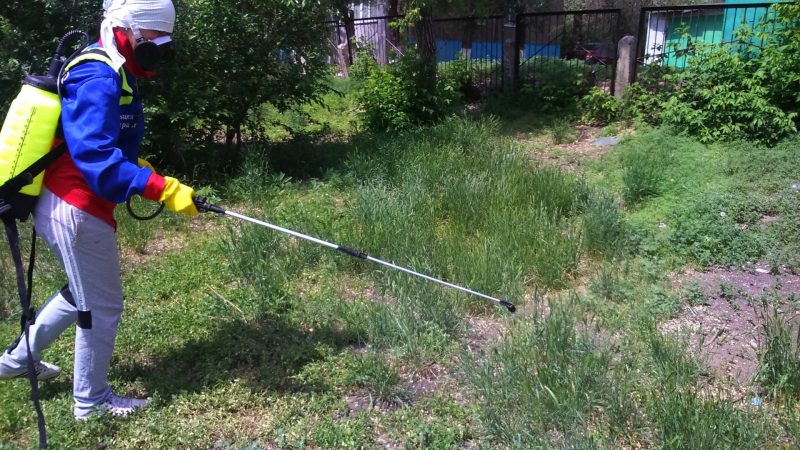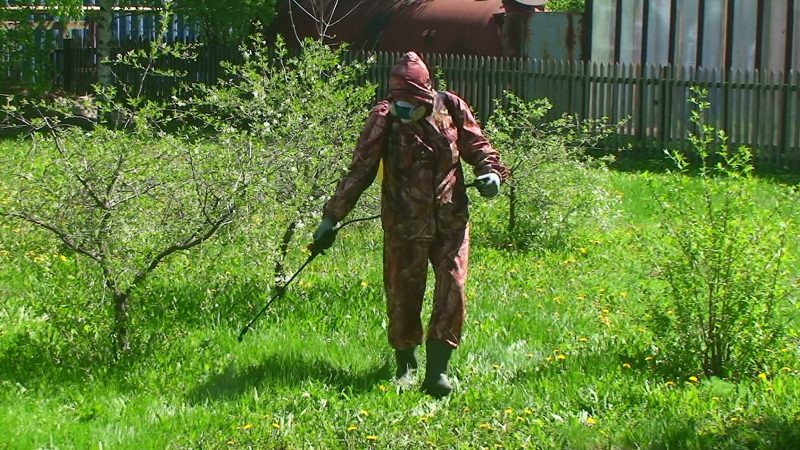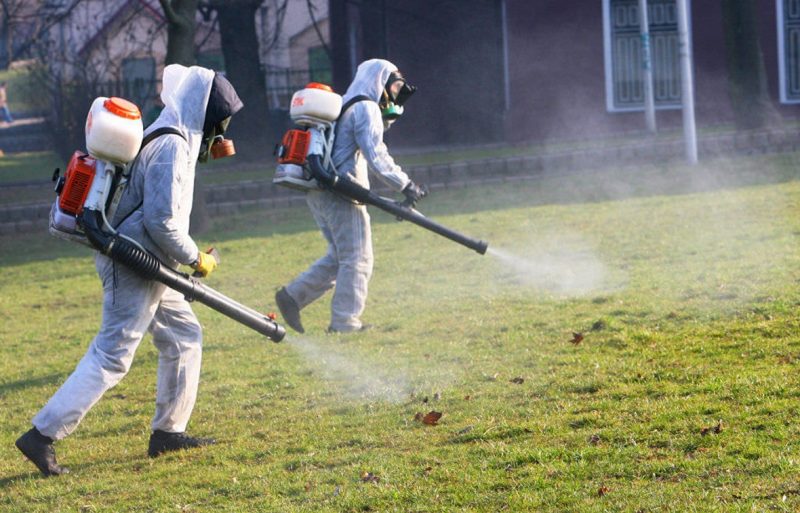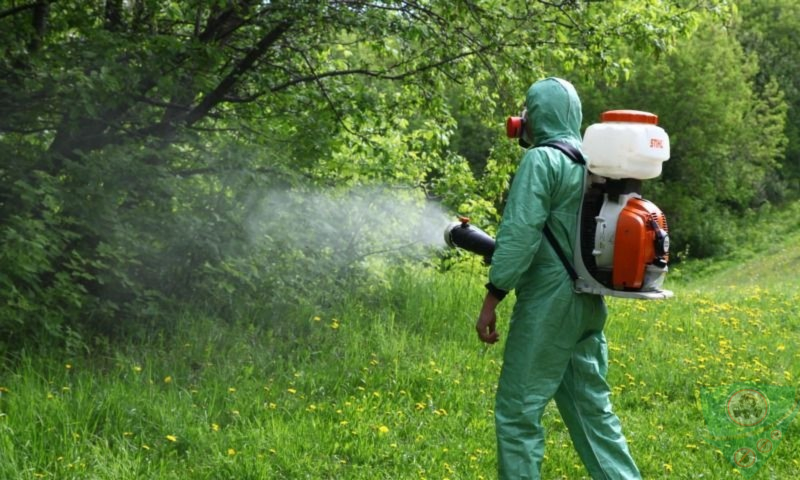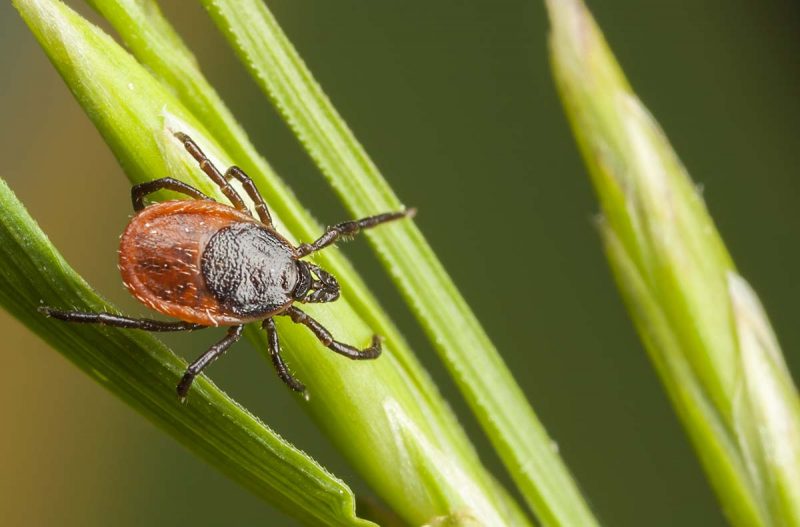Among this group of arthropods there are dangerous plant pests, carriers of pathogens of animal and human diseases. The treatment of the site from ticks is carried out independently or with the help of professionals. You can use folk remedies or chemicals.
Material Content:
Causes of parasites in the garden
Among ticks there are dangerous plant pests. The most famous: ordinary arachnoid, gall, red fruit, strawberry, currant bud, garlic. Phytophages spread by using infected planting material, high temperature and humidity.
Ixodid ticks are ectoparasites of humans and many vertebrates. The habitats of small bloodsuckers are territories from the Arctic Circle to the steppes in the south, from the Baltic to the Pacific coast. The probability of meeting with ixodid ticks is higher in the forest, on the pasture, in the overgrowth thickets.
In spring, ticks climb up the blades of grass and branches of woody-shrub plants. They can "travel" to new areas, attaching themselves to the skin of animals and people, on shoes, clothes, and bags. After July-September, tick nutrition ceases. Parasites hibernate in the same area where they feed.
It is impossible to get rid of ticks once and for all. Acaricidal treatment allows for some time to reduce the number of parasites to a minimum.In the warm season, spray the site or use other methods of control.
What harm do insects do?
Often, all small plant pests, flying and wingless blood-sucking parasites are called insects. This misconception arose due to the small size of organisms, a similar "appearance" and lifestyle.
Ticks have 8 legs, belong to arachnids, a subclass of Acari. Insects - Insecta, or hexapods, is another class of arthropods.
Spider mites suck juices from cultivated and wild plants. Affected leaves turn yellow and fall. Soil mites feed on bulbs, root crops, less often - on land parts of plants. Gallic ticks parasitize in the kidneys, inside the leaves, transmit pathogens of viral diseases. Plants weaken, leaves, flowers and young fruits are deformed.
Ixodid ticks are blood-sucking parasites of humans and animals:
- prefer the shady edges of mixed forests, thickets of tall grass;
- become infected by pathogens, eating infected blood of animals;
- active during the warm season of the year (peak in May – June);
- suffer serious infectious diseases.
Females for laying eggs and larvae for development require a large portion of the blood of wild or domestic vertebrates, humans. Keep in mind that ticks do not fly. Blood-sucking parasites expect their “prey” on the branches and leaves of plants at about 50 - 150 cm. Females hide in the grass at the ground level for laying eggs.
To clean the territory of the site and from ixodid and any other ticks, you need to conduct treatment with a folk remedy or acaricidal drug. If pests are concentrated in a small area, then they can be collected and destroyed.
Self processing of land from ticks
Insecticides are effective against insects. To control ticks, acaricidal drugs are used that reduce the number of this group of pests. The site is treated once in the warm season, with severe infection - more often.
Self-treatment from ticks and insects is carried out by insectoacaricides in the form of concentrated suspensions, tablets, powders. Each form has its own method of application.
Occupational Acaricides
Various pesticides are used in rooms, greenhouses and greenhouses, in personal garden plots to combat ticks. The active components are mainly organophosphorus compounds (FOS) or pyrethroids. The second are synthetic analogues of natural substances found in feverfew (Dalmatian chamomile).
Insect acaricidal agents from ticks for the treatment of the site:
- “Dobrohim FOS”;
- Sipaz-Super;
- "Karate Zeon";
- "Anti-tick";
- "Clipper";
- Apollo
- "Ram".
Pyrethroid acaricides spray the territory of the site and agricultural plants. Active substances - cypermethrin and its derivatives. You can use the universal preparation "Tsifoks" to treat the site of ticks, mosquitoes and midges, the premises - from flies, mosquitoes and cockroaches. The tool paralyzes the nervous system of larvae and adult insects. They are sprayed with outerwear and boots to destroy ixodid ticks.
“Tsifoks” is diluted with tap water to obtain a 0.1% solution (1 g of product per 1 liter of water). The shelf life of an already diluted drug is 8 hours. To process a garden plot, large-droplet sprayers designed for large volumes of liquid are usually used.
More materials:cytoxox
The active substance of the drug "Taran" is a third-generation pyrethroid - zeta-cypermethrin. Concentrated liquid is released in 5 liter canisters. For processing, a small-droplet knapsack spray or a fog generator (aerosol) is used. "Taran" is used in agriculture and for professional disinsection by specialists of organizations that have the right to engage in this type of activity.The drug is approved for use in personal subsidiary plots, household.
The drug from ticks "Dobrohim-FOS" is a powerful insecticide and acaricide. It is used by specialists of SES, professional pest control centers and the public. "Dobrohim-FOS" kills ticks on the site and all types of insects that annoy people in everyday life, lasts for 4-6 weeks. After heavy rainfall, the effectiveness of the drug decreases
Advantages of treating the FOS area and pyrethroids:
- quick destruction of pests and parasites;
- resistance to elevated temperatures;
- lack of toxicity to plants;
- low consumption rates;
- ease of use.
“Dobrohim-FOS” refers to 3, cypermethrins - to 2 to 3 hazard classes for people (medium and moderate toxicity to humans).
Analogs:
- “Dobrohim-FOS” - “Medilis-Super”, “Forssight Gel”;
- Tsifoksa - Inta-Vir, Medilis-Tsiper, Sipaz-Super;
- “Tarana” - “FAS Super”.
Funds can be purchased in packaging from 50 ml to 5 liters. Affordable drug - “Tsifoks”. The cost of a bottle of 50 ml is 200 rubles.
Folk remedies for getting rid of parasites
Decoctions of Caucasian or Persian daisies (feverfews), tobacco leaves and another 4-5 plants are poisonous to ticks, but practically do not harm human health, domestic animals. This happens because plant matter quickly decomposes, does not accumulate.
According to popular recipes, the collected herbs must be dried, chopped, boiled or infused in cold water. Hot or cold solution should be filtered and drained into a glass dish, buried tightly. If you prepare a large amount of the product, then the residues can be stored in a cool place for up to 2 months to use for repeated treatments of the cottage area from ticks.
You can plant insect-acaricidal chamomiles and calendula, which repel parasites.
Folk remedies do not give such a quick effect on the garden plot as "chemistry", that is, pesticides. It is better to use insect acaricidal plants and decoctions of them for prevention.
Chemical methods of control
Pesticides are the most reliable means to get rid of ticks. It should be remembered that in cans for processing open parts of the body, repellents are released that only repel bloodsucking parasites. Acaricidal agents are not applied to the body.
Highly effective chemical compounds are diluted to the desired concentration and sprayed using special equipment.
Tick control in the area:
- Processing is carried out several days after rain and 3 to 5 days before the predicted precipitation.
- The suspension or tablets are dissolved in accordance with the instructions, which indicate the ratio of water to means, the number of hundred parts for which the drug is designed.
- Thoroughly mix the working emulsion, fill the apparatus for spraying pesticides.
- A freshly prepared solution is used to spray the site in calm weather in the morning or evening hours.
- Be sure to use protective equipment: special glasses, a respirator, a hat or a scarf for hair, overalls, latex gloves, rubber boots.
- After treatment, take a shower or wash your face and hands thoroughly with soap.
Any insecticaricidal drug is diluted and used strictly in accordance with the manufacturer's recommendations listed on the package or in the attached instructions. Do not exceed the dosage, otherwise the risk of poisoning people, pets, death of beneficial insects, and inhibition of plant development increases.
Mechanical methods
This method is used with a small population of the site by ixodid ticks, a small number of pests on plants.
Physico-mechanical methods of struggle are distinguished by laboriousness and relatively low efficiency. The most commonly used collection and destruction of plants, their individual parts affected by tick pests.
Flightless small bloodsuckers are caught with a soft towel in bright colors.It is best to collect ixodid ticks on the site in the early morning. They straighten the towel and pass it through the grass and bushes. Parasites are destroyed (burned).
Prevention of the appearance of ticks in the suburban area
It is possible to make a fence from a fine mesh so that stray dogs, hedgehogs, hares do not penetrate. Ultrasonic repellers and poisoned baits will help get rid of rodents.
Vertebrate animals carry ticks, are also intermediate hosts for microscopic pathogens.
Weeds should be mowed, last year's grass, dead wood and fallen leaves removed. A reliable method for the destruction of wintering pests and parasites, their eggs and larvae is the burning of plant debris. The cleaner the site, the lower the risk of the appearance and spread of ticks.
To prevent infection by phytophages, it is necessary to properly cultivate the soil and spray in a timely manner. If you purchase high-quality planting material of varieties resistant to insect and tick damage, then a minimum amount of chemical treatments will be required.


